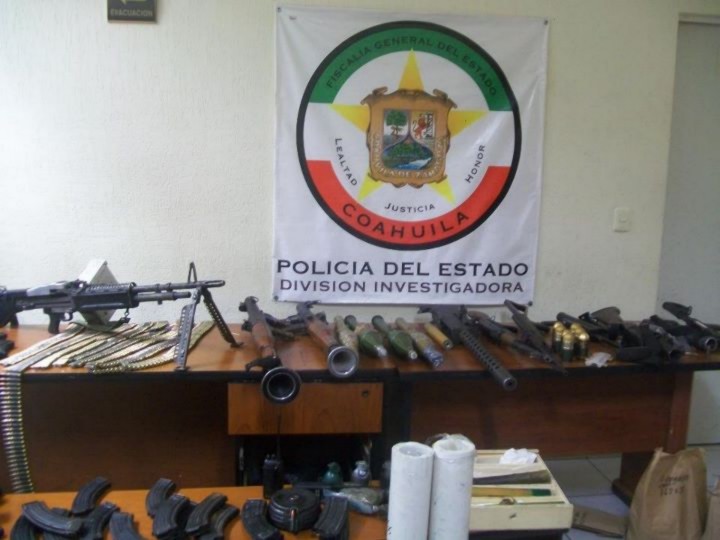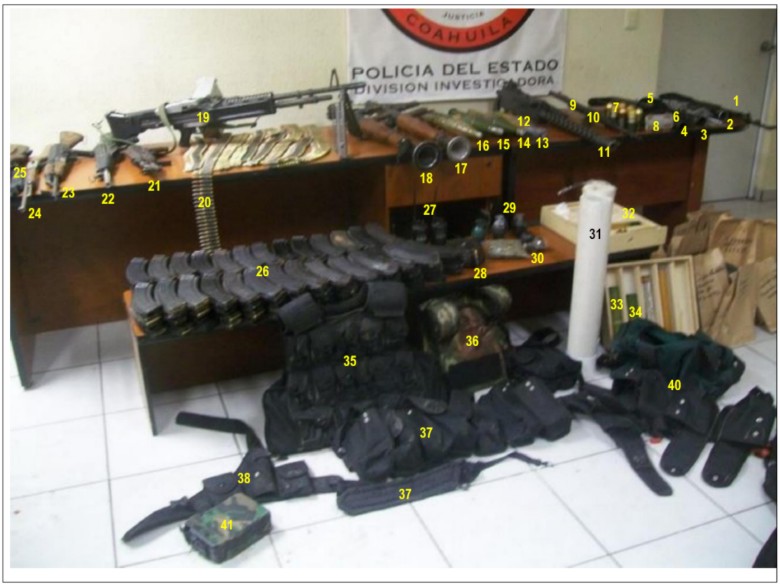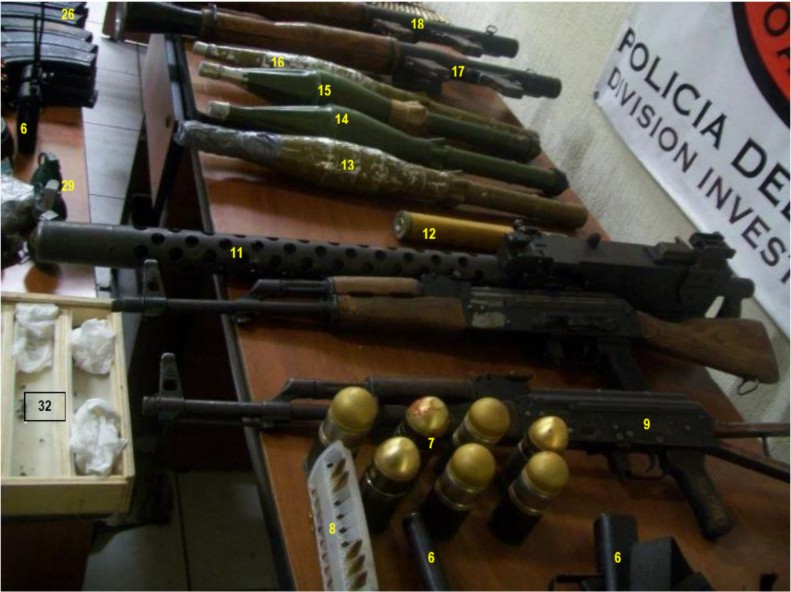Mexican Cartel Tactical Note #12: Forensics of Recovered Weapons from Piedras Negras Tactical Engagement Between Los Zetas and GATE (Grupo de Armas y Tácticas Especiales)
Note— Borderland Beat Reporter Chivis Martinez provided additional informational support pertaining to the Piedras Negras incident for this tactical note.
Key Information: Chivis Martinez “Gunmen in Piedras Negras Attack, Block Roads and Terrorize the City.” Borderland Beat, Wednesday, March 7, 2012, http://www.borderlandbeat.com/2012/03/gunmen-in-piedras-negras-attack-block.html?m=1.
Chaos and panic erupted last night in Piedras Negras, Coahuila, the Mexican city that shares the border with Eagle Pass Texas.
Around 8PM twitterers and libre network users began reporting that shootouts were occurring in various sectors of the city in what media sources are calling a “narco rebellion”. In the aftermath Sergio Sisbeles, a spokesman for security affairs of Coahuila, stated there were 10 known casualties of the attacks with no apparent losses by the narco group, but possibly there may be civilian casualties.
Elements of GATE (special weapons and tactics group) and the narco group engaged in battle on Highway 75 and various parts of Piedras Negras. Using combat weapons and granadazos (grenades) the attacks lasted for hours.
Terror gripped the city causing widespread turmoil. The first confrontation broke out on Highway 57 at around 5 PM and the Micare plant and offices. The violence triggered American federal authorities to close the two international bridges in Eagle Pass, Texas.
A girls softball tournament was in progress while the violence was occurring, as the shootout ensued close to the playing field creating hysteria by the players and those attending the game, as they ran to safety.
Buses were stopped by the gunmen, passengers robbed and the buses set afire.
The armed gunmen are believed to be the Los Zetas cartel known to have control of Piedras Negras and are most likely responsible for the attacks. The border with Mexico, Eagle Pass and Piedras Negras was closed to protect American citizens and prevent the violence from crossing over into the United States.
By using buses and a crane, it was the gunmen themselves that blocked highway 57, and the Acuna/Piedras highway, virtually isolating and paralyzing the city. Bullet ridden vehicles were left inoperable by the gunmen shooting out the tires leaving hundreds of “ponchallantas” (punctured tires) scattered and blocking the main traffic arteries of the city.
A GATE officer was killed in the shootings, Maria Guadalupe Delgadillo, age 21, was dead at the scene however her fellow officer was alive but seriously wounded, he and the other wounded officers were taken to IMSS Clinic 11 for medical treatment, one in critical condition, four others serious condition and five in fair condition.
Army tanks remained at the hospital to protect the safety of the wounded officers. This action was taken hoping to prevent the gunmen from gaining entrance and killing the officers, as often occurs in Mexico to survivors of such attacks.
Recently, Piedras was one of the border cities receiving additional security as additional troops arrived such as the Marina and equipment including helicopters. On Monday of this week GATE troops arrived, and clearly preventing even greater loss of human life and property.
UPDATE: Coahuila's Prosecutor's Office announced the arrest of Eusebio Hernandez Olivas, alias “El Chebo” and Eduardo Hernández Reyes alias “El Guero”. These individuals were arrested in the vicinity of the road that leads from Piedras Negras to the ciudad Acuña and were arrested for involvement in the Piedras attack. (see fotos below) The state also emphasized that the GATE elements were deployed to Piedras this week to combat the alarming elevation of kidnapping and carjacking incidents in the city.
Among the items confiscated from the attack:
- Black Durango model 2000
- A Toyota Tundra burgundy
- A GMC Sierra crew cab gray
- A Toyota Tundra, double cab, white, 2010 model
- A double cab DODGE RAM, color red, model 2010
- 50 AK-47s
- Two rocket launchers
- Three grenade launchers
- Grenades
- Ammunition
- Six radios (communication type)
- Three bullet-proof vests
- Camouflaged boots
- Camouflaged uniforms;
- HK machine gun with ammunition
- Machine gun MDD
- Long gun (shotgun)
- 20 long gun (R15
- A 22-caliber rifle
- A 33 caliber rifle
- Drugs
- An antenna base
The images of the captured weapons below are from Boletín de Prensa Piedras Negras- Detención 07 de Marzo 2012, https://www.facebook.com/notes/fiscal%C3%ADa-de-coahuila/bolet%C3%ADn-de-prensa-piedras-negras-detenci%C3%B3n-07-de-marzo-2012/337563779628298.
This photo is an untouched original.

GATE/For Public Distribution
Who: Between Los Zetas (assumed) and GATE.
What: An engagement between criminal insurgents and Mexican state authorities that turned into running gun battles with infantry small arms (assault rifles, light machine guns, thrown/launched grenades, and rocket propelled grenades). Vehicles (with tires shot out) and buses (set on fire) were utilized by Zeta tactical units to channel opposing forces (to create kill zones) and to block main avenues of approach/hinder the mobility of responding GATE/law enforcement elements. Note—The reporting of army tanks protecting the hospital is in error; rather armored cars (non-tracked vehicles) were deployed. Ten allied Mexican state casualties were noted from this engagement.
When: Initially at 5:00 PM and then from 8:00 PM on for hours afterward, on Tuesday, 6 March, 2012.
Where: On Highway 75 and in various parts of Piedras Negras, Coahuila (Across from Eagle Pass, Texas).
Why: The Mexican government is deploying additional forces to Piedras Negras in order to retake de facto political control of the city from Los Zetas.
Outside Expert Analysis: Sid Heal, a retired SWAT Captain (later Commander) with the Los Angeles Sheriff’s Department and retired CWO5 with the U.S. Marines, was asked to evaluate the level of this engagement. According to Commander Heal “Clearly, the confrontations between the authorities and criminals have escalated to war in all but name only.” After some reflection, he further went on to state:
One thing that occurred to me in retrospect is the long understood principle that the weaker adversary always seeks refuge. The nearest and safest refuge is a short distance to the north. Inevitably then, some of these violent episodes will follow and I believe we are starting to see that very thing. Moreover, there are historical precedents, not the least of which are the execution of 18 Americans by Pancho Villa in 1916 which resulted in the incursion by Gen. Pershing. Accordingly, if the Mexican government is unable to protect their own citizenry it is at least not incredible that they would seek refuge because it would provide both a temporary sanctuary and potential punitive actions against the assailants by a stronger government.
Commander Heal’s concerns are being echoed by many law enforcement officers along the U.S. Border. Increasingly, we are witnessing the emergence of zones of “dual-sovereignty” being established by the cartels on U.S. soil. The potential for the loss of
de facto political control in rural areas of Southern Texas across from Piedras Negras and other borderland towns controlled by the Mexican cartels is becoming a U.S. national security concern.
Photographic Analysis: The following two photographs originally posted by GATE have had numbers added to them in order to label and identify the various weapons and hardware recovered. A third photograph of weapons on the table has then been enhanced and has had numbers added. It should be noted that the cartels are increasingly being armed with military grade weaponry—the same weaponry that would be provided to squad and platoon sized military units of insurgent forces and national armies.

GATE/For Public Distribution

GATE/For Public Distribution
Note: This roster is a culmination of the weapons and/or components shown in main photograph, the photographic enhancement of the items to the extreme right (displayed on the table nearest the banner). Weapons and components were moved around as the photographs were taken and, therefore, some will appear only in certain photographs. Additional enhancement of the photographs has revealed the presence of certain weapons that were not previously apparent due to placement and lighting.
- AK-47, 7.62 X 39mm, fixed stock.
- Grenade launcher, 40mm, rifle mount (mount configuration unknown).
- Assorted Ammunition, Rifle, .30 caliber or greater, type unknown.
- Grenade launcher, 40mm, M-79, standard format.
- Grenade launcher, 40mm, Multiple, 6-round capacity, mfg. unknown.
- Grenade launcher, 40mm, HK 69A1 “Granatpistole,” retractable butt-stock (Heckler & Koch).
- (7) 40mm Spin-stabilized Grenades, HE // HEDP: (2) types present:
(4) Bearing strong resemblance to the U.S. M433 HEDP (Fragmentation / Shaped-charge).
(3) Bearing strong resemblance to the S. Korean K200 HE (Fragmentation / High Explosive).
- Ammunition, Rifle, .30 caliber or greater, type unknown.
- AK-47, 7.62 x 39mm, unknown origin, folding stock.
- AK-47, 7.62 x 39mm, military issue, fixed stock.
- Model 1919A4.30 cal. Browning Machine Gun, belt-fed, (U.S. produced or exact foreign copy).
- PG-7 Booster charge – for RPG-7 munitions.
- RPG round – PG-7VM (Romanian) HEAT with a modified fuze or an improvised fuze safety cover; heavily carried.
- RPG round – PG-7V Anti-tank; consistent with RFAS or Bulgarian mfg.
- RPG round – PG-7V Anti-tank; consistent with RFAS or Bulgarian mfg.
- RPG round – PG-7VM (Romanian) HEAT.
- RPG-7 Launcher, 40mm Russian (RFAS) or Eastern Bloc, heavily carried and recently fired.
- RPG-7 Launcher, 40mm Russian (RFAS) or Eastern Bloc, heavily carried.
- M-60 machine gun, 7.62 x 51mm, U.S. issue, produced sometime between 1996 and 1999.
- Ammunition, Military Ball, linked, 7.62 x 51mm (for the M-60).
- AK-47, Weapon origin uncertain, however, the folding stock that it is equipped indicates that it is Romanian, Polish, or post 1985 East German.
- Weapon not identifiable from view angle, but may be a semi-auto shotgun, box magazine fed.
- AK-47, 7.62 x 39mm, fixed stock.
- This firearm appears to be a pump-action rifle, .30 cal. or above, model / origin unknown.
- Limited item view prevents positive identification.
- Magazines, 7.62 x 39mm, 30-round capacity, loaded. Magazine count: 108 // Total rounds: 3,240 rnds.
- (2) Hand-held Transceivers (appear to be VHF).
- Magazine, Drum, 7.62 x 39mm, AKM, 75-round capacity.
- Hand Grenades, delay fragmentation, M-26A1 design, country of origin not identifiable; possibly: South African, South Korean, or U.S.
- Hand Grenade, appears to be an RFAS RDG-5 with UZRGM Fuze.
- Unknown container, possibly Deta-sheet (flexible explosive) rolled, or similar foreign compound.
- Packing container containing at least one PG-7 booster charge – for the PG-7 rounds.
- Canister, PG-7 booster charge.
- Canister, PG-7 booster charge.
- Tactical Vest, hand grenade configuration.
- Body armor, military.
- Tactical gear pouches.
- Tactical duty belt.
- Tactical Rifle sling, padded.
- Body Armor, tactical, threat level (Bullet resistance) unknown.
- This appears to be a ceramic plate/s for body armor shown (Item No. 40).
Note:
HK69A1 40mm Grenade launcher (“Granatpistole”) [Item No. 6; is a very high quality 40mm launcher that is produced in Germany and is in service with a number of military and police forces, all of which are overseas. There is a high likelihood that this weapon was hijacked or interdicted during a shipment of legitimate arms, possibly destined for delivery to the Mexican government. Another probable example of a hijacked weapon in this group would be Item No. 19, the M-60 Machine gun of U.S. mfg.
RPG-7 Presence: The presence of two RPG-7s’ (Item Nos. 17 & 18) in this cache may have significance based upon their origin. Components of the Mexican army appear to have fielded small numbers of RPG-7s within the past several years from sources currently unknown. The RPG-7 has seen very limited use on the southern continent, with the exception of the El Salvador conflict that occurred in Central America in the mid 1980’s. While the dates of manufacture of these weapons are not readily apparent, they appear far too new to be from the El Salvador conflict. They do however, appear, to be of European (RFAS or former Eastern Bloc) or Middle Eastern origin.
Significance: Arms Transfer; Cartel TTPs; Cartel Weapons; Cross Border Violence Potentials; SWAT; Urban Combat
Background Source(s):
Buggs, “Problems in Piedras Negras.” Borderland Beat, Sunday, October 16, 2011, http://www.borderlandbeat.com/2011/10/shootout-in-piedras-negras.html.
Overmex, “Mexico Army arrests 7 U.S. citizens in Piedras Negras, Coahuila.” Borderland Beat, Wednesday, September 7, 2011, http://www.borderlandbeat.com/2011/09/mexico-army-arrests-7-us-citizens-in.html.
Gerardo, “Piedras Negras in the Grip of Fear.” Borderland Beat, Friday, May 28, 2010, http://www.borderlandbeat.com/2010/05/piedras-negras-in-grip-of-fear.html.
Gerardo, “Fall from Grace.” Borderland Beat, Sunday, August 15, 2010, www.borderlandbeat.com/.../fall-from-grace.html.
